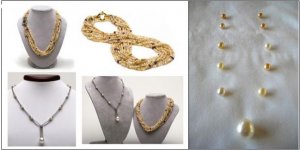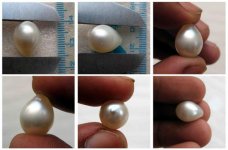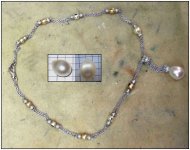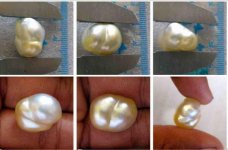SteveM
Well-known member
- Joined
- Jan 29, 2007
- Messages
- 2,083
This thread requires some review, and I propose to start with this post in the Pinctada Maculata thread concerning our necklace 'Poe Io Mata Nui' by Ben Bergman in Rarotonga.
Trepidation abounds in starting this thread (when has that stopped me before?), as it portends a culmination of sorts. I can't believe what has occurred, and it may yet end in disappointment. But as my entire pearl experience has been lived here, I will carry this to its conclusion with Pearl-Guide in mind.
Three posts are required to kick things off:
First:
Poe Io Mata Nui (10 Poe Pipi 5.7mm-7.2mm plus 13.5mm SS drop), Te Poe O Te Kuki Airani (1700 Poe Pipi 3mm-3.5mm), and the original loose pearl selection for Poe Io.
Background: Following our acquisition of Te Poe, we commissioned a second complementary piece that would feature fewer, albeit among the largest available, Poe Pipi. Bergman, upon discovering the finest SS drop of his professional career on a purchasing trip to Australia (his original home), allowed the SS drop to become an overwhelming focus of the piece, reluctantly sacrificing Poe Io's 100% natural qualification. The drop's size and white body also had the effect of robbing impact from the rarity and importance of the Poe Pipi.
We agreed with Ben at the time that should a natural pearl of comparable beauty be acquired, at any price, it would be substituted. Market price for a 14mm symmetrical Sejny drop in Bahrain is $100K, so it was a dream. Ideally, the pearl would also be a touch smaller in size, also for balance.
Trepidation abounds in starting this thread (when has that stopped me before?), as it portends a culmination of sorts. I can't believe what has occurred, and it may yet end in disappointment. But as my entire pearl experience has been lived here, I will carry this to its conclusion with Pearl-Guide in mind.
Three posts are required to kick things off:
First:
Poe Io Mata Nui (10 Poe Pipi 5.7mm-7.2mm plus 13.5mm SS drop), Te Poe O Te Kuki Airani (1700 Poe Pipi 3mm-3.5mm), and the original loose pearl selection for Poe Io.
Background: Following our acquisition of Te Poe, we commissioned a second complementary piece that would feature fewer, albeit among the largest available, Poe Pipi. Bergman, upon discovering the finest SS drop of his professional career on a purchasing trip to Australia (his original home), allowed the SS drop to become an overwhelming focus of the piece, reluctantly sacrificing Poe Io's 100% natural qualification. The drop's size and white body also had the effect of robbing impact from the rarity and importance of the Poe Pipi.
We agreed with Ben at the time that should a natural pearl of comparable beauty be acquired, at any price, it would be substituted. Market price for a 14mm symmetrical Sejny drop in Bahrain is $100K, so it was a dream. Ideally, the pearl would also be a touch smaller in size, also for balance.
Attachments
Last edited:




